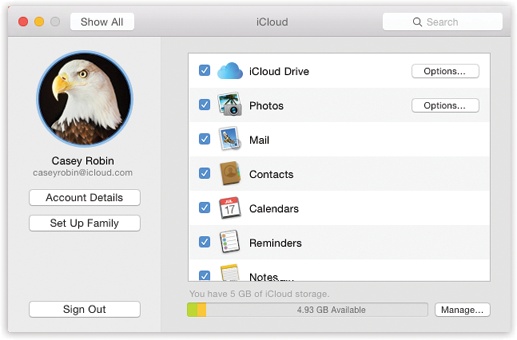Meet iCloud
In your time with the Mac, you’ll see frequent references to Apple’s free iCloud service. So what is iCloud?
It’s a huge array of features that are designed to make you glad you belong in the Apple ecosystem. iCloud synchronizes information across all your Macs, iPhones, iPads, iPod Touches, across family members, across the world, wirelessly and automatically. It keeps track of every song, book, movie, app, and TV show you’ve bought from Apple, so that you can download them onto any other gadget with an Apple logo on the back. It lets you find a lost Apple gadget. It gives you an email account. And a lot more.
The rest of this chapter details each of iCloud’s goodies, one at a time. They’re described in the order they appear in System Preferences→iCloud (Figure 10-8).

Figure 10-8. The headquarters of iCloud’s features. You’ll find a nearly identical pane on your iPhone, iPad, or iPod Touch (in Settings→iCloud).
iCloud Drive
The iCloud Drive is Apple’s version of Dropbox. It’s a folder, present on every Mac, iPhone, iPad, and iPod Touch, that lists whatever you’ve put into it—an online “disk” that holds 5 gigabytes (more, if you’re willing to pay money).
The iCloud Drive is a perfect place to put stuff you want to be able to access from any Apple gadget, wherever you go. It’s a great backup, too.
If you click Options (shown in Figure 10-8), you find two tabs. The first, Documents, ...
Get Switching to the Mac: The Missing Manual, Yosemite Edition now with the O’Reilly learning platform.
O’Reilly members experience books, live events, courses curated by job role, and more from O’Reilly and nearly 200 top publishers.

